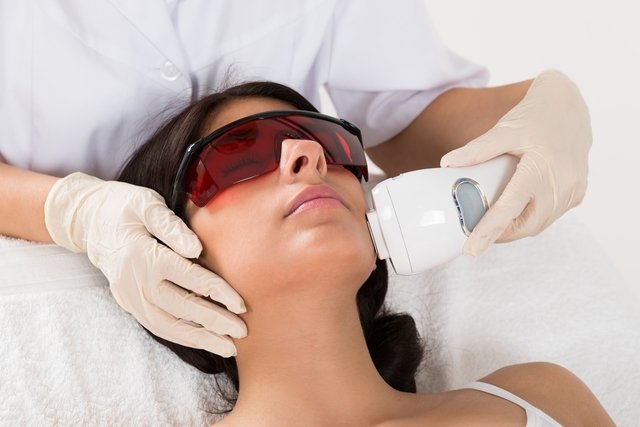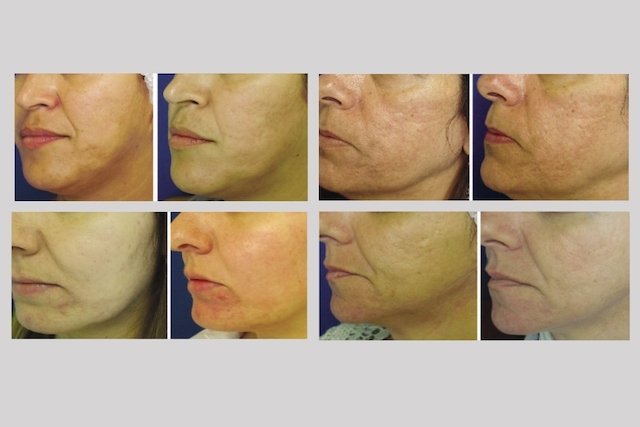The fractional CO2 laser is an aesthetic treatment indicated for rejuvenating the skin of the face, neck or hands, combating wrinkles all over the face and dark spots, in addition to removing acne scars.
This type of laser uses beams of light that penetrate the superficial and deep layers of the skin, reaching the epidermis and dermis, which cause localized thermal damage, stimulating collagen production and accelerating cell renewal.
The fractional CO2 laser, also called carbon dioxide laser, must be performed by a dermatologist or a professional specialized in dermato-functional aesthetics, and can be recommended for women or men.

What is it for
The fractional CO2 laser is normally indicated for:
- Wrinkles and expression lines;
- Improve skin texture;
- Facial or body sagging;
- Dark spots on the skin or melasma;
- Manch is old;
- Stretch marks;
- Acne scars on the face;
- Facial rejuvenation.
The fractional CO2 laser can be used in different areas of the body, such as the face, neck, hands, legs or even the abdomen, which depends on your indication and medical evaluation.
How to prepare
To prepare for the fractional CO2 laser, your doctor may recommend applying a whitening cream for people who have pigmentation problems or darker skin.
Furthermore, in the case of people who have cold sores, the doctor may recommend the use of antivirals to prevent new attacks.
Before the procedure, you must wash your face with water and neutral soap, do not use makeup and remove jewelry or jewelry.
How is done
The fractional CO2 laser is performed in the doctor’s office or at a specialist in dermatological aesthetics, and generally, an anesthetic cream is applied to the skin before treatment and protective glasses are used to avoid eye damage.
The therapist demarcates the region to be treated and then applies a gel to the skin and then the laser with several shots in a row, but not overlapping, which can cause some discomfort in the most sensitive people, and therefore it is recommended to use the anesthetic.
After treatment with fractional CO2 laser, the skin remains red and swollen for approximately 4-5 days, with gentle peeling of the entire treated region.
Generally, 3 to 6 sessions are required, with an interval of 45 to 60 days between them, and day after day you can notice an improvement in the general appearance of the skin, because the effect of the laser on collagen is not immediate, providing its reorganization, which may be more evident after 20 days of treatment.
After approximately 6 weeks it can be seen that the skin becomes firmer, with fewer wrinkles, fewer open pores, less relief, better texture and general appearance of the skin.
Care after the procedure
After carrying out laser treatment, some care is necessary, such as:
- Avoid very hot baths;
- Apply cold compresses for the first 24 hours to relieve swelling or burning;
- Apply moisturizing and repairing creams daily, recommended by your doctor;
- Use of sunscreen with a protection factor (SPF) above 30;
- Avoid exposure to the sun, and wear a hat to protect your skin from the harmful effects of the sun;
- Avoid removing peeling skin;
- Avoid using makeup until the skin has healed.
Furthermore, if the skin appears darker in certain areas after the treatment, the therapist may recommend a lightening cream until the next session.
When it is not indicated
The fractional CO2 laser is not recommended for pregnant women, or for people who have dark skin, very deep scars or keloids.
Furthermore, it should also not be performed on people with skin diseases, such as vitiligo, psoriasis, lupus, collagenosis, active acne, open wounds, burns or active herpes, and during the use of some medications, such as isotretinoin or anticoagulants.
Possible risks
Fractional CO2 laser treatment is generally well tolerated. However, some side effects may occur, such as:
- Intense peeling of the skin or formation of crusts;
- Skin swelling for up to 1 week;
- Post-inflammatory skin pigmentation;
- Activation of cold sores;
- Contact dermatitis.
In addition, small blisters may appear on the skin, bacterial infections or candidiasis may appear on the skin.
Bibliography
- ZHANG, DD; et al. The efficacy of fractional CO2 laser in acne scar treatment: A meta-analysis. Dermatol Ther. 34. 1; e14539, 2021
- OMI, T.; NUMANO, K. The Role of the CO2 Laser and Fractional CO2 Laser in Dermatology. Laser Ther. 23. 1; 49–60, 2014
- YUMEEN, S.; KHAN, T. IN: STATPEARLS (INTERNET). TREASURE ISLAND (FL): STATPEARLS PUBLISHING. Laser Carbon Dioxide Resurfacing. 2022. Available at: <https://www.ncbi.nlm.nih.gov/books/NBK560544/>. Accessed on January 23, 2023
- XU, Y.; DENG, Y. Ablative Fractional CO2 Laser for Facial Atrophic Acne Scars. Facial Plast Surg. 34. 2; 205-219, 2018
- KLOSOVÁ, H.; et al. Fractional CO2 laser therapy of hypertrophic scars – evaluation of efficacy and treatment protocol optimization. Acta Chir Plast. 63. 4; 171-180, 2021
- GOOD, Elisangela dos Santos, et al. Fractional laser resurfacing for atrophic acne scars: evaluation in the Brazilian population. Surg Cosmet Dermatol . Vol.7. 1.ed; 33-36, 2015

Sign up for our newsletter and stay up to date with exclusive news
that can transform your routine!
Warning: Undefined array key "title" in /home/storelat/public_html/wp-content/plugins/link-whisper-premium/templates/frontend/related-posts.php on line 12
Warning: Undefined array key "title_tag" in /home/storelat/public_html/wp-content/plugins/link-whisper-premium/templates/frontend/related-posts.php on line 13





